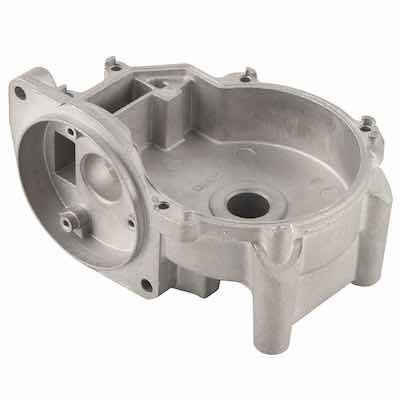A finisher in Italy needed help with aluminum castings that needed to be nickel-chromium plated.
They had been told that it is very difficult to electroplate aluminum castings with nickel-chromium and get satisfactory results, and wondered why it is so hard to properly plate aluminum castings.
While it may be hard, I assure them that aluminum castings are “properly” plated on a daily basis by the thousands. However, there are numerous issues with aluminum castings that need to be carefully considered and allowed for.
Metallurgical Nature of Aluminum Castings
 Frank AltmayerAluminum is a difficult metal to plate because it typically contains numerous alloying elements, and each can affect the electrochemical behavior of the alloy, which affects the cleaning and zincating that is employed prior to plating.
Frank AltmayerAluminum is a difficult metal to plate because it typically contains numerous alloying elements, and each can affect the electrochemical behavior of the alloy, which affects the cleaning and zincating that is employed prior to plating.
According to ASTM, commonly plated aluminum casting alloys (average alloy content) include elements listed in the accompanying table.
In general, the alloys that contain the lower concentrations of alloying elements tend to yield the least trouble in polishing/ buffing and plating. Therefore, in the table, the 518 alloy would be considered to be the most desirable from this standpoint, with the 443 alloy falling into the next best category. Of course, there are other considerations, such as ease of die casting and mechanical properties, to consider in choosing an alloy for production of a part.
For example, the 518 alloy is noted for being problematical in die casting. It has a tendency to crack when subjected to temperature changes, and it does not have a great ability to flow into thin sections, and it has a tendency to stick to the die surfaces (the 443 alloy has much better casting properties).
The silicon content of a die casting adds strength to the alloy, especially at elevated temperatures. However, as an alloying element, silicon plays a major role in causing plating problems:
- First, silicon is insoluble in almost any acid unless that acid is fortified with fluorides. If the acid does not effectively remove the silicon from the surface of the casting, blistering of the plated part may result.
- Second, the presence of large silicon inclusions on or near the surface of aluminum castings can yield polishing buffing problems, which (if not detected by inspection after buffing) lead to roughness after plating.
Some aluminum castings, after polishing and buffing, have a presence of large silicon inclusions near the surface that resulted in surface roughness. If this roughness is not detected by inspection prior to plating, there is a good chance the surface of the plated casting will be unacceptable after plating.
There is no effective method for the plater to repair such a casting. Even if the plater buffs the nickel plate, chances are the rough spots will not evenly buff out, or the particles will be pulled from the surface leaving a pit and a surface defect will be visible.
The key to this problem lies in the choice of casting alloy and the casting method. If high quality (low porosity and uniform, fine silicon distribution) castings are not available, a close inspection after polishing and buffing is required to eliminate the poorer quality castings from any lot sent to the plater.
The polisher/ buffer may minimize this effect by lubricating each polishing/buffing step as much as possible to avoid excessive heat buildup in the casting which can alter the physical make-up of the casting surface.
Alloying elements may be present as micro-particulates, inter-metallic compounds, or solid solutions. Variation in the alloy makeup, even when it is within the specification for a specific alloy, can cause the base metal to behave differently when processed via chemical treatment and during polishing-buffing of the castings.
It is well known that aluminum castings are porous. The cavity that the molten metal is discharged into is initially filled with air. Gating is provided to allow for the elimination of the air as the molten metal enters the cavity.
However, no gating is perfect, and some air will always be trapped inside the molten metal. How much of this air is trapped and where it produces pores is a function of numerous factors, including gate design, location, size and number, melt temperature, casting pressure, and die temperatures. If any of these are poorly controlled or designed, the casting will have porosity at or near the surface.
After polishing and buffing, these sub-surface pores may be revealed or may reside just below the surface. During processing prior to plating, enough metal may be chemically removed to reveal the sub-surface pores. Any surface pores will trap processing chemicals such as cleaners and acids.
After plating, the trapped chemicals will typically produce a blister and/or, in some cases, surface pits. Some platers attempt to correct poor-quality castings by applying a thick acid copper plate and then buffing the plated casting, in an effort to cover up surface porosity by smearing copper over and into the pores. This typically may work for surface pits that are microscopic in size, but is rarely successful for larger pores.
The Chemical Nature Of Aluminum Castings
 Aluminum readily reacts with oxygen to form an oxide film that is invisible, stable, and quick to re-form if removed. If not eliminated, this oxide film prevents the adhesion of any plated deposit. Therefore, aluminum can not be processed for plating by normal cleaning and acid pickling procedures.
Aluminum readily reacts with oxygen to form an oxide film that is invisible, stable, and quick to re-form if removed. If not eliminated, this oxide film prevents the adhesion of any plated deposit. Therefore, aluminum can not be processed for plating by normal cleaning and acid pickling procedures.
Further, the chemical processing must be designed to clean the aluminum surface and eliminate any surface impurities that would interfere with the production of a thin, firm film of zinc in the zincate processing step. Aluminum is an electrochemically active metal that will produce a galvanic couple with zinc, displacing the zinc from a solution of its ions.
By immersing clean aluminum in a solution that contains controlled amounts of zinc ions, the aluminum is dissolved into the solution, and a thin film of zinc is produced simultaneously. Once a dense zinc film is produced the dissolution of aluminum ends.
The alloying elements present in aluminum casting alloys (notably copper, iron, and silicon) are more noble than zinc, and therefore the alloying elements that are present on the surface of the casting, as it enters a zincating process, can retard the formation of a contiguous zinc film. The presence of any buffing compound or other non-metallic residues will also inhibit zinc film production. Therefore, the preparation of aluminum castings must include steps to remove surface contamination and any alloying elements on the surface.
The buffed castings need to be cleaned and acid pickled in such a manner that all buffing compound and surface alloying elements are removed.
Cleaning aluminum can be done in numerous ways, but the most effective method is vapor degreasing. If vapor degreasing is not viable, soak cleaning and electrocleaning in non-etching cleaners designed for use on aluminum can also be effective.
Use of ultrasonics in preparing castings for plating may be desirable, and very effective, when castings contain surface designs that trap buffing compound in crevices. However, ultrasonics may aggravate a surface porosity problem, by opening nearsurface pores that might otherwise stay closed. Also, if used, ultrasonics should be employed in cleaning solutions that are especially designed for such use. These are solutions that are low in dissolved solids content and high in detergency. Adding ultrasonics to a soak cleaner, for example, is not very effective, as these cleaners tend to be high in dissolved solids content, which inhibits cavitation.
The preparation cycle typically includes an acid pickle, which will dissolve surface alloying elements, and residuals that may be left on the surface by cleaners (such as silicates). Since most aluminum die castings contain some silicon and copper, the nitric acid used on castings needs to be fortified with fluorides to more adequately remove these metals from the surface, and to remove residual silicates from the cleaner(s).
Typical acid formulations that have been successfully used on silicon-containing casting alloys are:
- Nitric acid, 50% vol., containing 6lb./ 100 gal. (7 g/L) of ammonium bifluoride. This acid is used at 20°C – 30°C. Use at temperatures above 30°C, may cause localized etching or pitting.
- Tri-acid, (50% vol. nitric, 25% vol. sulfuric, 60 g/L ammonium bifluoride or 2% volume hydrofluoric acid). This acid is also used at 20°C – 30°C. Use at temperatures above 30°C, may cause localized etching or pitting.
An acid that works well on alloys containing high amounts of magnesium is: Sulfuric acid, 25% vol., at 80°C – 85°C (2–5 minutes) followed by a brief dip in 50% nitric acid at 20°C – 30°C.
If the acid dipping process does not effectively remove silicon and other alloying elements from the surface, blistering either immediately after plating or delayed blistering when the part is subjected to extreme temperature may result.
Immersion times in any of the above acids typically are around 30–60 seconds, but times may need to be adjusted/ optimized for each alloy. Because the immersion time in the acid is brief and the amount of time is important, a timer should be used when processing parts manually.
The acid needs to be analyzed on a regular basis, based upon elapsed time for high production operations and based on square meters processed for intermittent production.
The Zincate Process
To obtain the highest degree of adhesion on aluminum castings, we recommend the use of a double zincate process from a dilute formulation. Research has shown this to yield a thinner, more adherent zinc film.
The immersion time of parts in the zincate should be carefully controlled to within the suggested time frame of the supplier of the zincate formulation, especially, the second zincate film. The immersion times are typically between 30 seconds and two minutes, depending on formulation. When double zincating, the second dip is normally much shorter in time than the first (typically 10–15 seconds). The use of a timer is important for manually produced zincate films.
Temperature and quality of rinsing after zincating are also commonly ignored variables. The maximum temperature is typically 27°C. Zincating at too high a temperature will compromise adhesion.
The first rinse after zincating needs to flow at a high rate, so that additional zinc coating(s) are not produced in the rinse. A low flow rate makes the rinse a secondary zincating tank, yielding a lower than normal level of adhesion.
Frank Altmayer is a Master Surface Finisher and an AESF Fellow who is the technical education director of the AESF Foundation and NASF. He owned Scientific Control Laboratories from 1986 to 2007 and has over 50 years of experience in metal finishing. He was the recipient of the AESF Past Presidents Award, NAMF Award of Special Recognition, AESF Leadership Award, AESF Fellowship Award, Chicago Branch AESF Geldzahler Service Award, and NASF Award of Special Recognition.
Image courtesy of https://www.3erp.com/



































